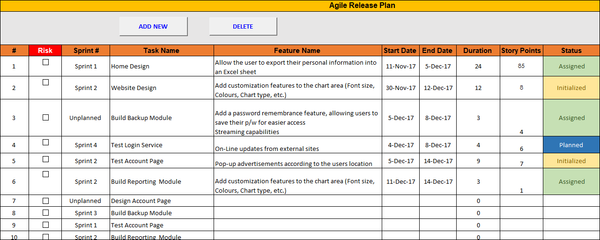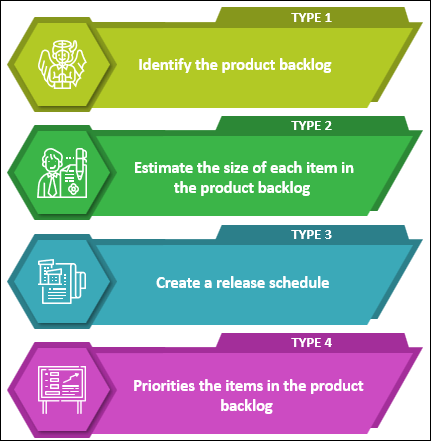Agile Release Planning
What Is Agile Release Planning?
Agile Release Planning is a process that helps organizations to plan and manage agile software development projects. The process includes creating a product backlog, prioritizing items in the backlog, and creating a sprint backlog. Additionally, the process helps organizations track progress and identify risks.

The Agile Release Planning process is an important part of agile software development because it helps organizations to create a road map for the project. Additionally, the process helps organizations track progress and identify risks. By understanding the process, organizations can more effectively manage agile software development projects.
Agile Release Planning Involves Four Key Steps:
- Choose the release date
- Write user stories
- Create the product backlog
- Prioritize the user stories
The process is flexible and can be adapted to the needs of the organization. It is also scalable, so it can be used for small projects as well as large ones.
An agile development process, it introduces the concept of a sprint, or iteration, which is a period during which a team strives to complete a set of pre-defined tasks.
During a sprint, the team members work together to create a deliverable, which is usually a working version of the software. At the end of each sprint, the team holds a sprint review meeting to assess their progress and plan for the next sprint.
The sprint review is followed by a sprint retrospective meeting, where the team discusses what went well and what could be improved. These two meetings are the main elements of a sprint cycle.
Sprint cycles are repeated until the software is completed and ready for release.
Why is Agile Release Planning Important?
The agile release planning process is important for several reasons. First, it provides a framework for teams to plan and track their work. Second, it helps ensure that teams can deliver value to stakeholders in a timely and efficient manner. Third, it helps reduce the risk of project failure by providing a clear and concise road map for teams to follow.
One of the key benefits of agile release planning is that it helps teams to focus on delivering value to stakeholders. By providing a clear and concise road map, teams can stay on track and deliver features and functionality that stakeholders need and want. In addition, agile release planning helps to reduce the risk of project failure by providing a clear plan for teams to follow.
Release planning also has several benefits for scrum teams. It can help improve communication and collaboration between team members. It can also help teams to identify risks and potential problems early in the project.
What Is the Goal of Agile Release Planning?
The goal of agile release planning is to identify and schedule the delivery of features that will provide the most value to the customer.
During agile release planning, the product owner and the development team come together to discuss the features that need to be delivered in the upcoming sprints. The product owner priorities the features, and the development team estimates the effort required to implement each feature.
After the features have been prioritized and estimated, the development team creates a sprint backlog, which is a list of the tasks that need to be completed to implement the features selected for the upcoming sprint.
The sprint backlog is used by the development team as a guide during the sprint. It helps the team track their progress and ensure that they are on track to deliver the features by the end of the sprint.
4 Steps for Building an Agile Release Plan?

The agile release plan is a road map that outlines the delivery schedule for a software product under development. It is designed to be flexible and adaptable, responding to changes in customer requirements or technology.
The agile release plan is an important tool for project management, as it provides visibility into the work that needs to be done and the order in which it needs to be done. It also allows stakeholders to track progress and identify potential risks.
The Following are Four Steps for Building an Agile Release Plan:
1. Identify the Product Backlog:
The product backlog is used to track and prioritize the work that needs to be done to build a product that meets the needs of the customer or client. The product backlog is also used to track the progress of the development team as they work through the backlog items.
The product backlog is a living document that is constantly being updated and revised as new information is learned about the product and the market.
2. Estimate the Size of Each Item in the Product Backlog:
The product backlog is a list of all the work that needs to be done on a project. The backlog is typically maintained by the product owner and is used to prioritize the work that needs to be done.
To prioritize the work in the backlog, the product owner needs to estimate the size of each item in the backlog. There are several ways to do this, but the most common method is to use the Fibonacci sequence.
The Fibonacci sequence is a series of numbers where each number is the sum of the previous two. The sequence starts with 0, 1, 1, 2, 3, 5, 8, 13, 21, 34, 55, 89, 144, 233, 377…
The next number in the sequence is always the sum of the previous two numbers.
3. Create a Release Schedule:
The release schedule is one of the key deliverables of an agile release plan. It gives the team a high-level view of when features will be delivered to the customer. The release schedule is a living document that is updated throughout the life of the project.
4. Prioritize the Items in the Product Backlog:
As the product owner, you are responsible for the product backlog. The product backlog is a prioritized list of everything that needs to be done to complete the project.
You need to continuously update the product backlog as new information arises and priorities change. The product backlog is used to create the agile release plan, which is a high-level road map for the project.
The agile release plan highlights the features that will be delivered in each iteration. It also provides an overview of the timeline for the project and the resources that will be required.



